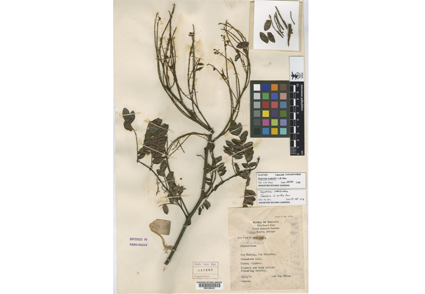Abstract
The new species Biancaea scabrida, currently only known from Peninsular Malaysia, is described and illustrated. The new species most resembles B. parviflora and B. oppositifolia in its inflorescence, but can be distinguished from both species by its sepals which have short stiff scabrid hairs, and its pistil which has stiff and hispid hairs. It also has alternately arranged leaves and inflorescence branches, a lack of a persistent suborbicular stipule, few pinnae per rachis (2–6 pairs) and relatively fewer leaflets per pinna ((3–)5–9 pairs). A provisional IUCN conservation assessment and a taxonomic key to Biancaea is also provided here.
References
Desfontaines, R.L. (1818) Description de Quatre Nouveux Genres de Plantes. Mémoires du Muséum d’histoire naturelle iv: 245–248
Gagnon, E., Lewis, G.P., Sotuyo, J.S., Hughes, C.E. & Bruneau, A. (2013) A molecular phylogeny of Caesalpinia sensu lato: Increased sampling reveals new insights and more genera than expected. South African Journal of Botany 89: 111–127. https://doi.org/10.1016/j.sajb.2013.07.027
Gagnon, E., Bruneau, A., Hughes, C.E., de Queiroz, L.P. & Lewis, G.P. (2016) A new generic system for the pantropical Caesalpinia group (Leguminosae). PhytoKeys 71: 1–160. https://doi.org/10.3897/phytokeys.71.9203
Hattink, T.A. (1974) A revision of Malesian Caesalpinia including Mezoneuron (Leguminosae-Caesalpiniaceae). Reinwardtia 9: 1–69.
Hou, D. (1996) Caesalpinia. In: Hou, D., Larsen, K. & Larsen, S.S. (eds.) Caesalpiniaceae. Flora Malesiana, ser. 1, Seed Plants, vol. 12. Rijksherbarium, Leiden, pp. 535–555.
IUCN (2012) IUCN Red List categories and criteria. Version 3.1. 2nd edition. IUCN: Gland, Switzerland and Cambridge, UK, v + 32 pp.
IUCN Standards and Petitions Subcommittee (2019) Guidelines for Using the IUCN Red List Categories and Criteria. Version 14. Prepared by the Standards and Petitions Subcommittee. Available from: https://nc.iucnredlist.org/redlist/content/attachment_files/RedListGuidelines.pdf (accessed 27 November 2020)
Kiew, R., Rafidah, A.R., Ong, P.T. & Ummul-Nazrah, A.R. (2017) Limestone treasures: Rare plants in Peninsular Malaysia – What they are, where they grow and how to conserve them? Malaysian Naturalist 71: 32–41.
Rahman, R.A. & Kiew, R. (2018) Strategy to Conserve Maximum Biodiversity of Limestone Flora in Peninsular Malaysia. Sibbaldia: The International Journal of Botanic Garden Horticulture 16: 57–66. https://doi.org/10.24823/Sibbaldia.2018.247
Linnaeus, C. (1753) Species Plantarum. Vol. 1. Laurentius Salvius, Stockholm, pp. 1–560.
Molinari Novoa, E.A., Mayta Anco, L.F. & Sánchez Ocharan, C. (2016) Notulae Nomenclaturales IV. Transfers to Biancaea. Weberbauerella 1: 1–3.
Prain, D. (1897) Materials for a Flora of the Malay Peninsula. Journal of the Asiatic Society of Bengal, Pt. 2, Natural History 66: 1–345.
Roth, A.W. (1821) Novae Plantarum Species praesertim Indiae Orientalis. Sumptibus H. Vogleri, Halberstadii [Halberstadt], pp. IV + 412. https://doi.org/10.5962/bhl.title.10723
Schwabe, K.A., Carson, R.T., DeShazo, J.R., Potts, M.D., Reese, A.N. & Vincent, J.R. (2015) Creation of Malaysia’s Royal Belum State Park: A Case Study of Conservation in a Developing Country. The Journal of Environment & Development 24: 54–81. https://doi.org/10.1177/1070496514551173
Todaro, A. (1860) Nuovi Generi e Nuove Specie di Piante Coltivate nel Real Orto Botanico di Palermo. Fascicle 2. Stamperia di R. Pagano e C. Piola, Palermo, pp. 78.


